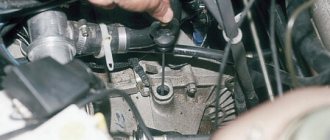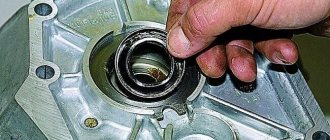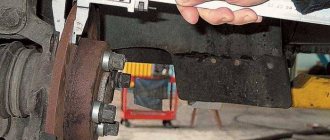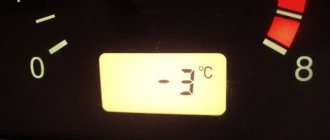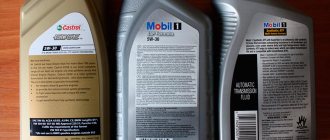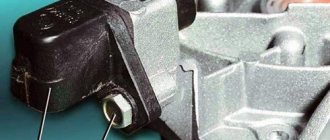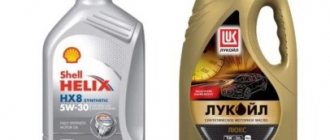Published:
20.01.2016
A routine check of the oil level in the gearbox can result in an unpleasant surprise in the form of foaming gear oil. Foaming can be easily identified by a large number of small bubbles on the surface of the dipstick. This symptom indicates a malfunction that can lead to extremely unpleasant consequences. Foam does not allow components to be lubricated properly, which leads to overheating, electronic malfunctions, difficulties during gear shifting, or even serious damage. We will look into why the oil in the gearbox foams in this article.
Sometimes when checking the oil level you may find bubbles on the dipstick.
Mixing liquids
When replacing technical fluids in a car, it is extremely important to remember that it is not advisable to mix different fluids. This is often the sin of car owners who want to save money. Mixing two oils from different brands or brands may cause foaming. The formation of foam in this case is the result of a chemical reaction that can occur between the various components of the oils. In this case, the oil mixture loses its protective properties. As a result, the use of such oil leads to increased wear of the transmission.
In this situation, the only and obvious solution is to change the oil. The replacement must be done by flushing the gearbox with a specialized fluid, which will remove all remnants of the old process fluid. It is best to leave the car in the hands of specialists to avoid any breakdowns. However, if you have the appropriate skills, you can wash the gearbox yourself. In the latter case, it is worth remembering that flushing must be done until there are no traces of used oil left in the flushing liquid. If the design includes a filter, then before washing it must be removed, and before adding new liquid, a new filter must be installed.
Oil level
Another very common reason why automatic transmission oil foams is a high oil level. There is an opinion among some mechanics that a slightly increased oil level in the box has a beneficial effect on the operation of the transmission. Many motorists listen to this, but forget that this recommendation does not apply to all cars. Mercedes-Benz, Volkswagen, BMW and Toyota cars are most sensitive to high oil levels. In addition to foaming, overfilling can lead to rupture of gaskets, damage to valves and clutches.
Check the oil level according to the instructions. The main thing in this case is the temperature of the test. As a rule, before checking the oil level, you need to drive about five kilometers, then wait 2-3 minutes. And only then check the oil level. If the oil level is higher than normal, then the excess must be drained.
In addition, a low level of technical fluid is extremely dangerous, regardless of whether the car has a manual or automatic transmission. The level must be checked in the same way as per the instructions. If there is a lack of fluid, it must be topped up. Otherwise, this could destroy transmissions that have proven themselves to be extremely reliable.
What should the driver do?
The first signals of a malfunction in the machine will be jolts and jerks when changing gears. Next, the automatic transmission will begin to skip or block gears, and then the hydraulic and electronic parts will fail.
In order not to miss the moment when the oil begins to foam, you need to regularly check its level and quality. Reliable measurements are obtained only after heating the working fluid to 80 - 90℃:
- Having previously driven 10 - 20 km, the car is stopped on a horizontal platform.
- The selector is set to “P” or “N” depending on the transmission model.
- At idle, take out the dipstick, wipe it dry, insert it back into the pipe for 5 seconds and take it out again.
- The correct ATF level is between the “Hot” notches.
- Red or light yellow oil indicates good condition.
- When checking the consistency, the oil should be immediately absorbed into the napkin.
Depending on the manufacturer, the checking algorithm may change; for example, in Honda, the dipstick is checked after turning off the engine.
Troubleshooting
If the ATF level is below about:
- It is necessary to inspect the underbody of the car in search of leaks from the automatic transmission and carry out repairs if broken hoses, deformed parts, or worn gaskets are found;
- Add the same ATF that is filled into the box to the required level.
When the oil foams, its volume increases, so the level on the dipstick will be above the top notch. To make sure, when checking again, turn off the heated engine and wait until the liquid settles. Excess oil is drawn out using a technical syringe and a thin tube.
If foam in the gearbox oil occurs due to aging, overheating, or an unsuccessful mix of various fluids:
- Remove and wash the pan.
- Completely drain the unusable liquid.
- Replace filters.
- Clean the radiator.
- Fill with fresh fluid recommended by the manufacturer.
Read
Do-it-yourself oil change in a Renault Fluence automatic transmission
In the most advanced cases, it will be necessary to overhaul, diagnose and replace automatic transmission parts. In order not to bring the transmission to repair, you need to take into account the design features of both gasoline and diesel automatic transmissions during operation:
- sudden movements at the start and during braking overload the torque converter;
- when slipping for a long time or towing heavy trailers, the automatic machine overheats due to high loads;
- Automatic transmission needs regular maintenance.
Liquid leak
Foam in the transmission can form due to a large volume of air, which can replace fluid over time. Air ingress occurs due to a violation of the tightness of the components. For example, air can enter through cracks or when a hose ruptures. In case of such damage, the operation of the car is contraindicated, since with each kilometer the quality of the lubricant will only decrease. To identify such a malfunction, it is necessary to make a visual inspection and pay attention to the following elements of the gearbox:
- oil seals, rubber rings and gaskets, hoses;
- a plate connecting the engine and transmission;
- bottom of the transmission housing.
A leak can be detected by traces of liquid that have a characteristic color. Fixing a leak is not the final step. As a result of a leak in the seal, dirt may enter the liquid along with air, and the liquid itself may lose its properties, so it is recommended to replace it.
Neglect of maintenance
As you know, any technical fluid cannot retain its properties forever, so its timely replacement is always required. If you refer to the vehicle manual, the transmission fluid replacement intervals are naturally indicated with a certain reserve. This was done in order to extend the service life. However, if the specified intervals are significantly exceeded, foam may appear in the gearbox. Timely replacement will eliminate foaming and undesirable consequences. The replacement interval depends on the type of gearbox and the type of oil. We can provide the following expert recommendations:
- Synthetic in manual transmission - at least 70 thousand km.
- Synthetic in automatic transmission - at least 50 thousand km.
- Synthetic in the variator - at least 30 thousand km.
- Mineral in manual transmission - every 30 thousand km.
- Mineral in automatic transmission - every 20-30 thousand km.
The above intervals may vary depending on operating conditions. The frequency of fluid changes may increase when driving off-road or sitting for a long time in traffic jams. Under these conditions, the loads increase slightly, which can lead to a reduction in the replacement interval by up to 1.5 times. For more accurate information, please refer to the vehicle manual.
Overheat
Fans of very active driving must be aware of oil foaming. Owners of expensive and powerful cars who spare no money on maintenance may also wonder why the oil in an automatic transmission foams. During very active driving, the oil may overheat, as indicated by the indicator on the dashboard. Owners of cars with a manual transmission can only guess about the temperature of the oil in the box. But there are no unsolvable problems. You can control the temperature using special sensors, which can warn the owner in time that the pace needs to be slowed down somewhat.
Useful tips and tricks
Please note that if large and sparse air bubbles are visible on the dipstick when checking, this does not indicate that the oil is foaming. If the engine and gearbox have recently been operating in active mode at high speeds, isolated bubbles are allowed in the wave and this is the norm. Foamed oil is a fairly evenly foamed liquid with small air bubbles.
You also need to take into account that if there is little foam, this leads to an increase in its volume, then when checked, the level will be too high. To accurately determine the level, you need to warm up the automatic transmission, then turn off the engine and let the oil settle.
Then check the level with the engine turned off. Often the dipstick may be dry, which indicates a strong drop in level. Next, you need to start the engine and repeat the test to get a more objective assessment. Usually, when the level is low, the oil will foam after starting the engine and the level will rise, which will be visible on the dipstick.
If there is an overflow of oil into the automatic transmission, foaming will not occur immediately after starting the engine, but after driving under load and at high speeds. In this case, foaming will also increase the volume of the liquid. In this case, excess oil will be squeezed out through the gearbox breather. To confirm, you can inspect the gearbox and the location of the breather. If there is overflow, the breather will be in oil, and it is also quite possible for the entire box to become oily.
Finally, we note that often, especially when installing contract automatic transmissions on a car, a new engine and automatic transmission oil dipstick is installed before sale. At the same time, probes for different models may fit the neck, but differ in length.
So, if the dipstick level is below normal, but the oil foams and ATF “drives” through the box breather, there is a high probability that the dipstick is not entirely suitable for this automatic transmission. In such a situation, the box kicks, the owner believes that the level is low and adds oil. However, in reality there is an overflow with all the ensuing consequences.
Timely repairs
Immediately after detecting foam and identifying the causes of foaming in the gearbox oil, all problems must be eliminated as quickly as possible. If nothing is done, then after 10 thousand kilometers the cost of repairs can increase many times over, since a regular oil change will not restore worn-out components. The first thing you need to pay attention to is the fluid level and its compliance with the recommendations. Changing the fluid will help avoid re-foaming, for which your car will only thank you. If you were unable to identify the cause on your own, you should not postpone your visit to a specialist for too long. Have you encountered this problem?
Urgent repair
When you determine the cause of foaming in the oil, you need to get rid of it as soon as possible. Without taking the necessary actions, after 10,000-20,000 kilometers the price of the work will increase, because worn parts will be added to the strange state of the oil. First you need to check the suggested oil level and, if necessary, change it. It is recommended to change the technical fluid so that the problems do not recur. If you are unable to determine the source of the problem yourself, do not hesitate to take your vehicle to a service station. Take care of yourself and your transport!
